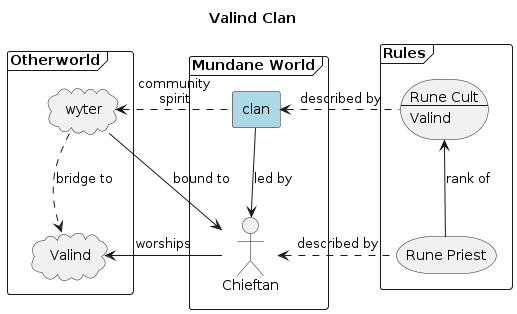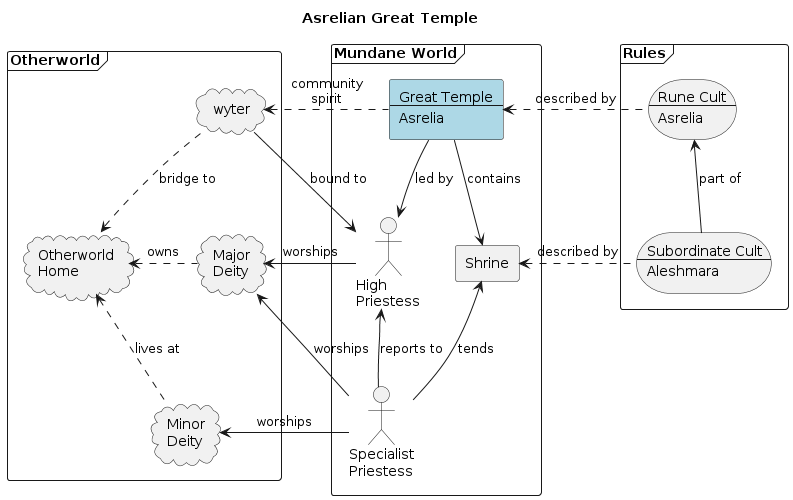Cults of Runequest: Clans
The previous blog entry described Rune Cults in abstract rules terms. This by itself is enough for running an adventure-focused game, where rune cults serve a game function much like that of D&D character classes.
However, many people prefer a community-focused game, in the style of the Red Cow campaign or Six Seasons in Sartar. This requires a somewhat deeper understanding of how the rules portray the setting, in particular what a clan is.
In the RQ:G rules, the term clan is used in much the same way as in popular anthropology; a group of people united by actual or perceived kinship and descent, especially when part of a larger group such as a tribe, nation or empire. Membership of a clan is by birth, marriage or adoption; being a member of more than one clan is normally not possible. Clans typically make a better focus of a community-focused campaign than cults themselves, simply because they allow a greater diversity of characters.
Using the default character generation rules, all characters are born into a clan. However, there is little in the explicit rules that explains how clan, tribe and cult relate to each other. So, as these rules are intended to be usable for running such community-focused campaigns, this blog post takes a closer look at how this works.
To do this, we look at 3 examples of clan-level community:
- a Valind clan, organised around a single temple, led by a priest
- a great temple to Asrelia, organised around a single large temple led by a chief priest, presiding over subservient cults
- an Orlanth Thunderous clan, organised around a pair of temples to Orlanth and Ernalda, run by a chieftain
For each case, there are three perspectives; the Otherworld of gods and spirits, the mundane world of people and temples, and then the game rules that describe them.
Note that in Dragon Pass, almost all clans are organised into tribes and tribal federations, which add an extra level of complexity and options. These will will be looked at in the next part of this series.
Valind Clan

Some clans support initiation into only a single rune or spirit cult; clan and cult membership are synonymous. Clans following this pattern are commonly run by the senior Rune Priest, Shaman Priest or Rune Lord. It is possible for a senior initiate to temporarily lead a clan, but such a clan will be greatly magically weakened if a more appropriate replacement is not soon found.
It is not possible to be a full member of the clan, or marry into it, without being or becoming an initiate of the clan cult. The clan maintains a community spirit, or wyter, which provides a bridge to a specific deity on the God Plane. Such a deity is almost always massively more powerful and long lasting than a spirit directly contactable by a shaman.
The clan wyter is responsible for detecting and enforcing any behavior taboos or restrictions described in the cult write-up. It knows what the community knows, and what the priest and deity tell it. So a secret successfully kept from the clan, and not revealed during worship, may stay a secret. It also teaches cult spirit magic, at the discretion of the community leader. Many clans have additional spirit magic available from their wyter; some rare ones provide specialist Rune magic too.
As such clans are literally a monoculture, they perhaps represent a better place to have come from than a setting for a long-term campaign.
Perhaps as this somewhat matches the contemporary real-world usage of the word 'cult', it's a common misconception that all Gloranthan clans are this way. However, while they are a clear minority of clans, they do exist. Examples include:
- Hsunchen clans such as the Telmori
- Clans following Valind, from the glacier lands where agriculture is not possible
- Isolationist or refugee ethnic groups that follow Daka Fal ancestor worship
- Tusk Riders following the cult of the Bloody Tusk.
- Riverfolk following Heler or Engizi.
Some God Learners speculated that this was the primordial form of social organisation from which all others derive. Others thought that it was the easiest to create, or recreate after a catastrophe. So usually it would be newer than other, more complex, forms of religious organisation.
Some cult-based organisations like Storm Bull warbands, Yggite pirate crews and Gagarthi bandit gangs have a similar organisation internally. However, they are not usually counted as clans as they rarely bring up children. It would be highly unusual to be born into one; instead you join them in adulthood.
Asrelian Great Temple
Sometimes, great or major temples of a cult own and control their own lands, within which people are born and raised. Within those lands, the cult is entirely dominant, structuring society as much as a primordial clan does. Other examples include the Paps in Prax, Old Wind in Sartar, and the Shaker Temple in Tarsh. However, due to the size and magical power of temples of that size, an additional level of complexity is present. This corresponding to the RQ:G term subordinate cult.

Some great temples and temple complexes, whether they count as clans or not, support subordinate cults. These are run by Specialist Priests, typically of Godtalker rank. These report to the temple High Priestess, tend a shrine, and worship a lesser deity who resides at the otherwold home of the great deity in question. Such specialist priests are recruited from the general population of cult initiates; there is not a separate community of those dedicated to the subordinate cult. Consequently, there will pretty much never be a full cult writeup available, as the number of actual members of the subordinate cult is negligible.
The net result is that if the subordinate cult provides rune magic, it is available to all cult initiates, subject to the discretion of the Chief priest. This could be considered to be cult association, but with a single cult managing both ends of the relationship.
For example, in Esrolia, the independent Great Temple Asrelia's Retreat maintains a subservient cult to Aleshmara, a Pamaltean deity. This was initially set up by persuading a priestess of that cult to cross the ocean and set up shop in the temple. The daughter of that original priestess initiated to Asrelia when she came of age, and now tends the shine her mother established. That provides the Rune Spell Bounty to all Asrelia cult members who visit the temple. This process was ruinously expensive in both wealth and magical power, but the cult hierarchy considers it a sound investment.
Great temples can be interesting and useful places to visit, if only because they contain magic available nowhere else. However, they make a poor setting for a typical campaign, as there is still only a single cult that initiates must belong to.
Orlanth Thunderous Clan
One common pattern of clan worship is where a clan supports two temples to two associated cults, representing deities who are husband and wife. Normally, when a clan worships two cults, this causes divisions within the community,. This weakens the wyter and commonly leads to the split of the clan into two. Having the two cults be segregated by gender, and then tied together by marriage avoids that. The two temples share a shrine (or sometimes two shrines) representing the bond. This makes available the two rune spells listed under the associated cults section of their writeup. For example, for a clan focused around Orlanth Thunderous and Ernalda, the shrine would make available Heal Body and Cloud Call.
The work of tending the shrine is shared between the two priesthoods. The clan is led by a Chieftan, who ideally should qualify as a Rune Lord and/or Priest. Note that the rules section 'Chief priest' applies to either; the chieftan of an Orlanthi clan is only required to be an initiate of Orlanth.

As the Orlanth Rune Cult write-up is split into subcults, it is necessary to specify which one the clan temple corresponds to; in this case Orlanth Thunderous. The Ernalda cult write-up is not so split, so the temple is described by the writeup directly. This should not be taken to mean that all clan-level Ernalda temples are identical, merely that there is no systematic pattern to how they vary.
This type of clan is recommended for a community-based campaign, as it is possible, with some flexibility, to accommodate initiates of many different cults into the clan.
For all genders, initiation into the clan precedes initiation into a specific temple, cult or subcult. taking the form of a minor heroquest as described in 6SiS. This gives the new adult access to the Otherworld palace Orlanth and Ernalda share. From there, forming a connection to any deity who lives at that palace, including most of the Lightbringers and Ernalda's family is normally automatically successful. Those who chose to form such a connection become initiates of that specific god. If using the RoS rules, this counts as a friendly transfer between cults. Those who do not transfer remain in Orlanth or Ernalda.
Those who fail the adulthood ordeal must successfully initiate to some other acceptable god in order to count as a full clan member; hunter gods are the most common alternate path. Those who do not find such a path are usually supported by the clan, so long as hope remains that they some day will.
Exceptional performance at the adulthood initiation heroquest can earn a single use of any rune spell available to the clan. This is generally taken as an omen. For example someone who starts as an Ernaldan and is awarded the Lightning spell will likely be directed to the path of Vinga. In the abscence of such a clear sign, the clan elders use their best judgement, taking account of both the needs of the community and the wishes and capability of the young adult.
Completing initiation to the level represented by the default character generation rules (i.e. 21 years old with 3 rune spells and a reasonable level of cult skills) requires access to a full temple,which will likely not be present locally to the clan. If the temple is available at tribal, or tribal association, level, this is routine. Otherwise it may require a long and dangerous pilgrimage to a foreign temple, who may or may not accept the candidate. It is GM's discretion whether his can be assumed to have taken place before play. If not, they will have more RP than spells known.
Ernalda's other husband-protectors include Argan Argar, Flamal, Lodril, Magasta, Pamalt, Strom Bull, Yelm and Yelmalio. So any of these deities can replace Orlanth. although only Yelmalio (sometimes called Elmal), Lodril and Argan Argar do so in the Dragon Pass region. In Prax, it is her daughter Eiritha who is married to Waha.
Edited by radmonger
updated diagrams
-
 2
2


0 Comments
Recommended Comments
There are no comments to display.